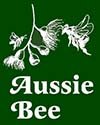ASIAN HONEYBEES IN AUSTRALIA
Aussie Bee > Feral Bees in Australia > Asian Honey Bees
Please report any Asian Honeybees that you see (except those in the Cairns region of Queensland) by phoning the Exotic Plant Pest Hotline on 1800 084 881. Your call will be transferred to the relevant authority in your state or territory. More information on how to report sightings.
Asian Honeybees are a feral bee species that threatens our environment and our commercial honey industry. Unfortunately a large population of Asian Honeybees has become established in the Cairns region of Queensland.
How to Recognise the Asian Honeybee
The Asian Honeybee (Apis cerana) (10 mm) is smaller than the European Honeybee (Apis mellifera) (15 mm) that we use for honey production in Australia. It tends to fly faster and more erratically. It is less hairy and has more prominent banding on the abdomen than the European Honeybee. More information and photos on the Bee Aware website.

Above: the feral Asian Honey Bee, Apis cerana, (right) is smaller and has more distinct bands than the commercial European Honey Bee, Apis mellifera, (left). Photo by Paul Zborowski / Queensland Government.
Asian Honeybees in Cairns, Queensland
A nest of the Java strain of Asian Honeybees (Apis cerana) was discovered inside the mast of a fishing boat in Cairns in May 2007. Searches revealed a total of seven colonies in the area. The bees probably originally arrived on a ship from Papua New Guinea or Indonesian Papua. Asian Honeybees pose a significant threat to our environment and to the honey industry, so an eradication program was started.
Unfortunately, by 2011 nearly 500 nests and swarms had been found in the Cairns region. The eradication program was then abandoned and the focus shifted to just trying to manage these pest bees. By 2017 these feral Asian Honeybees had spread in Queensland from Mena Creek in the south, to Mossman in the north, to Atherton in the west.
Asian Honeybees in Townsville, Queensland
More nests of Asian Honey Bees were detected and destroyed in Townsville in 2016. These bees probably came from Papua New Guinea. Alarmingly, bees from two of the nests were carrying Varroa mites. Varroa destructor mites are devastating parasites of our commercial Honeybees but fortunately the mites carried by the Townsville bees turned out to be the less dangerous Varroa jacobsoni species.
It is hoped that the eradication program in Townsville has now successfully destroyed this Asian Honey Bee population but restrictions on moving all live bees in the Townsville area still apply in 2018.
The public is also asked to report any Asian Honeybees or feral Honeybee nests in Townsville by ringing 13 25 23.
Impact of Feral Asian Honeybees
1. Feral Asian Honeybees will compete with native bees, birds and mammals for food and nesting sites.
'The impact of Asian bees on Australia’s ecology is likely to be highly significant. There are hundreds of native animals that consume nectar and/or pollen as part of their diet. Asian bees will be a significant competitor for nectar and pollen plus occupy small cavities displacing native birds and possums.' Source: NSW Government factsheet (Industry & Investment NSW, 2010)
2. As they become established in urban areas, Asian Honeybees are also likely to become a serious nuisance to the public.
'The density of Asian bee colonies is said to be three times greater than honey bee colonies. The propensity of Asian bee colonies to swarm several times per year and their preference for human habitation areas will create significant public nuisance costs in the form of swarm removal and increased levels of stinging events.' Source: NSW Government factsheet (Industry & Investment NSW, 2010)
3. Furthermore, these feral Asian Honeybees threaten Australia's $90 million honey industry and pollination services worth up to $6 billion.
'They will be major competitors for nectar and pollen, thus reducing the honey crops produced by honey bees. Given the evidence gathered in the Solomon Islands, they are also likely to invade honey bee colonies to rob their stored honey during periods of no natural nectar supply. Asian bees are also potential hosts of varroa mites, which are extremely devastating to honey bee colonies.'
Source: NSW Government factsheet (Industry & Investment NSW, 2010)
Please report any Asian Honeybees that you see (except those in the Cairns region of Queensland) by phoning the Exotic Plant Pest Hotline on 1800 084 881. Your call will be transferred to the relevant authority in your state or territory. More information on how to report sightings.



